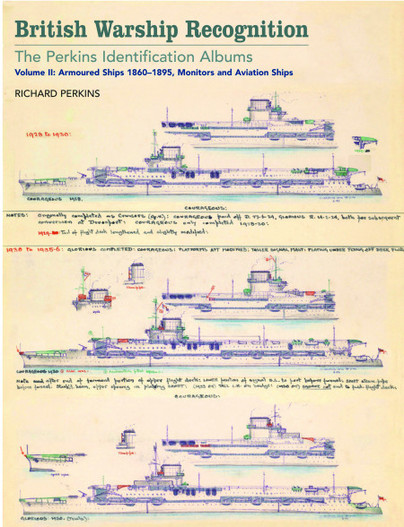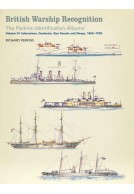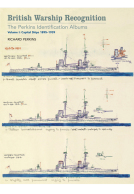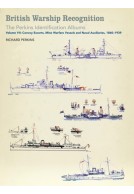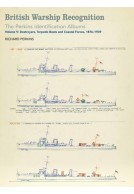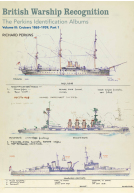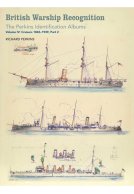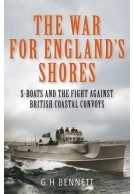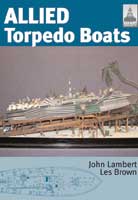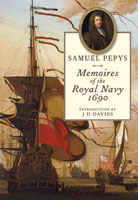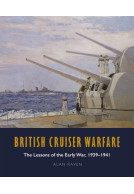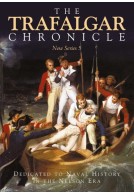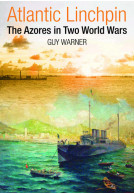British Warship Recognition: The Perkins Identification Albums, Volume II (ePub)
Armoured Ships 1860-1895, Monitors and Aviation Ships

Series: Perkins Identification Albums
File Size: 95.9 MB (.epub)
Pages: 224
Illustrations: 500
ISBN: 9781848323889
Published: 5th September 2016
| Other formats available | Price |
|---|---|
| British Warship Recognition: The… Hardback Add to Basket | £60.00 |
The Richard Perkins warship identification albums form one of the most detailed studies ever undertaken of the changes to the appearance of Royal Navy ships. However, it is a unique hand-drawn manuscript artefact in the care of the National Maritime Museum, so despite its value it is rarely seen by anyone besides the museum’s curators, for whom it is a precious resource, used on an almost daily basis.
In collaboration with the Museum, Seaforth is undertaking the first publication of this monumental work in a superbly produced multi-volume edition that captures all the qualities of the original. Every page is reproduced at full size, making the extensive hand-written annotation readable, while the fine-line drawings retain all the colours that Perkins used to denote appearance differences and alterations.
Following the Museum’s binding arrangement, this second volume of the series covers armoured ships from Warrior to the Royal Sovereigns (all later capital ships from the Majestic class onwards can be found in Volume I), as well as monitors and seaplane and aircraft carriers.
This is a publishing event of the utmost importance for every enthusiast and ship modeller, who for the first time will be able to own a copy of a unique and invaluable reference work.
An incredible continuation to a publisized version of The Perkins Identification Albums. An amazing collection of accurately recorded etchings of ship of the British Royal Navy!
Armorama
Read the full review here
This series of books is one that I would likely have passed over, had I not seen them at the bookstore where I work. I am so very glad I did come across them, because they are a brilliant example of the kind of content that can result from good partnerships between libraries, archives and publishers...
The Northern Mariner / Le marin du nord, XVIII, No. 2 (Spring 2018) – reviewed by Sam McLean Toronto, Ontario
... well worth a place of pride on any coffee table or bookshelf. I especially recommend these books for those who are interested in the Royal Navy 1870-1939, and anybody who enjoys studying the minutiae of warship design, fittings and decorations.
An underutilized gem long trapped in the repositories of the National Maritime Museum, the publication of this volume and other will be of great importance to those with an interest in the Royal Navy during the eight decades prior to the Second World War.
The Northern Mariner, July 2017 - reviewed by Charles Ross Patterson II, Yorktown, Virginia
The books are big but with Volume II and the rest of the collection they provide a unique view of the Royal Navy in the later 19th and early 20th centuries, a view that you will not see in a Brassey’s, a Conway’s or indeed a Janes. You may need a larger bookshelf or broader coffee table but the payoff is enjoying a cup of NATO standard, and flicking through the drawings and admiring his talent.
Thomo's Hole - reviewed by Ian Thompson
Read the complete review here.
Whether one is interested in the subject or not, and this reviewer must admit that he is not particularly, the effort, detail and love that has gone into the production of the pictures in this book trumps all.
The Naval Review, May 2017
A well produced and substantial collection which is an invaluable reference work.
Mariner's Mirror
NOTE: reviewed alongside Volume 1
Warship 2017, reviewed by Stephen Dent
These are the first two of what is intended to be an eight volume series with the overall title ‘The Perkins Identification Albums’ and, assuming that the same high standard of presentation and production is maintained, a
truly remarkable series it promises to be...
... The result is undeniably impressive. The level of detail is remarkable, with notes on where ships were stationed at different times, details of funnel markings, and coverage even extending to the harbour service careers of
many of the Victorian ironclads...
...Volume II not only covers three wildly diverse types of vessel but does so in a somewhat idiosyncratic fashion ...
... For some the price will undoubtedly be a deterrent to purchase, but for photograph collectors, modellers, and anyone else interested in the development and appearance of Royal Navy warships during the period the books are likely to be regarded as indispensable.
This book, which is the second in a probable series of eight volumes, is excellent value for money. I have only one complaint, I will need to invest in new shelves to hold these remarkable volumes! Highly recommended.
Marine News, February 2017
As featured on Army Rumour Service!
ARRSE
As featured online!
ModelShipWrights
Individual Volumes of the Perkins Collection certainly do not need due to the fact that the entire collection as a whole is an amazing accounting to the British fleet of ships between 1860 and 1939 and that it is also a highly coveted resource used by historians and enthusiasts when referencing any of these ships to this day. Richard Perkins dedicated himself to categorizing each of these ships in such detail and with as much accuracy as was possible. I can confidently say after seeing Volume I and now with British Warship Recognition – The Perkins Identification Albums Volume II: Armored Ships 1860-1895, Monitors and Aviation Ships, that these reproduced volumes form the Perkins Collection would make an essential addition to anyone’s personal library.
MSC Review Connect
Read the full review here.
The coloured profiles of all these ships, some famous and other not so famous, are delightful to see in their own right, with the obvious care and attention to detail that a real enthusiast has devoted to them over many years. What they make is pretty much a recognition bible for anyone wanting to identify individual ships in old photographs, and the whole collection would therefore be a museum photo curator's dream reference. In saying that it would be very easy or them to remain just that, a valuable resource hidden away in a museum collection and accessible to only a few. By the National Maritime Museum and Seaforth working together to produce these excellent quality copies, anyone can have access to this marvelous resource. Not only is it an invaluable photo interpretation reference, but the volume and detail all carefully noted and coloured by hand over many years of an individual's obvious passion is simply delightful to see in its' own right. With this first one looking at Capital Ships, the remaining 7 volumes are certainly to be looked forward to, and there are notes in the book of just what is included in each of the other albums to come.
Military Modelling, Robin Buckland
A real gem for any enthusiast of an era when the Royal Navy did 'Rule the Waves' and if you examine period photos, an unrivalled reference.
Read the full review here.
Here we have the second volume of the quite extraordinary warship recognition albums made by a remarkable man named Richard Perkins before the Second World War. He held a vast collection of warship photographs and produced beautiful drawings of the ships that interested him so he could plot the differences in classes and following refits to aid in the identification of particular vessels.
War History Online, Mark Barnes
If anything, this volume is even more appealing than the first...
There is no question a book like this is pretty niche. The format is huge, and the price tag reflects the quality of the reproduction of Mr Perkins wonderful drawings. Happily, his archive is safe in the hands of the National Maritime Museum at Greenwich, and we are likely to see more in this series. Mr Perkins’ books are just the sort of thing that would have been torn up to make individually framed prints in less enlightened times so fans of his work are all winners here. I would also like to see his photograph collection presented in book form. Perhaps that is on the agenda. Until then more of his beautiful drawings and efficient notes will be most welcome. Gorgeous stuff.
A priceless masterpiece!
José Manuél Rico Cortés (Mister JM) - Miniaturas JM
Read the full review here.
As with its companion volume on Royal Navy Battleships and Battlecruisers, this work is worthy of such superlatives as ‘Remarkable’ and ‘Impressive’.
NZ Crown Mines
This reviewer had previously viewed Volume 1 of this series, and was very impressed with that work. Volume 2 is in a similar vein. It is a highly-detailed record of the changes made to specific vessels of the Royal Navy in the course of their service careers. That a single individual was dedicated-enough to undertake such a task is, at the very least, remarkable. Even more remarkable is the fact that this volume (as with its companions in the series) was originally created as one man’s reference work for his personal use. Intended to act as an aide memoir to his collection of naval photographs, it was never intended for public viewing. That it survived much relocation over the years before being donated to the National Maritime Museum is something for which those interested in naval history in general and the Royal Navy in particular, should be thankful.
As noted in Volume 1 of this series, the author decided to ‘…Document faithfully the appearance and alterations made to…many hundreds of British warships…’ Accomplishing this required the taking of numerous images of Royal Navy vessels, which in turn led to the creation of a photographic collection of considerable size. Recognition Manuals were created to detail the alterations that each ship underwent. The scale and accuracy of the drawings within these led to the author being eventually recognised as an authority on the ships of the Royal Navy, the illustrations being both a national treasure and a research tool of immense value.
The volume’s Publisher’s Note states that ‘The aim of this published edition is to replicate as faithfully as possible the experience of consulting the beautiful original…albums. To this end, each page has been reproduced at full size having been photographed at the highest possible resolution’. In the original album, illustrations were drawn on paper rectangles which were glued to a larger page of newsprint. Time has caused both types of paper to turn yellow and when placed on this book’s larger white pages, the result adds to the overall charm of the volume, while implying the ‘history’ which lurks within.
The majority of ships illustrated within this work comprise those vessels in service in the Royal Navy between 1860, and 1895. Within this broad classification, various subheadings appear. Amongst others, these cover such specialist vessels as Old Battleships, Broadside Ships and Floating Batteries. The vessels within such headings are then investigated in detail with each and every modification they carried during their naval career being clearly and carefully detailed. It is at this point that this work’s value becomes apparent and its creator’s dedication to his craft very evident.
A pen and ink image depicts each vessel in profile, with water-colour paints being used to give depth and shade. Clear and legible hand-written details of the vessel’s naval career appear below each image.
Although most vessels are represented by a single profile, others are portrayed through the use of yearly blocks of varying length. Doing this required the creation of more hand-drawn images – all to the same high standard. Smaller ‘scrap-type’ illustrations notate any differences between individual vessels within a class and any modifications undergone by the specific vessel. These can typically include alterations made to armament, masts, funnels and searchlights. The modifications are colour-coded. The effect is astonishing, and it is possible to follow the progress and ‘evolution’ of a ship from its service entry, through its various refits to its final withdrawal. An added bonus is the presence of images of several vessels in their ‘retirement’ phase of being hulks, a feature not usually found in recognition works such as these.
Not content with merely investigating the older classes of battleships and their ilk, the author also presents images and modifications for other vessels. The most notable of these are the so-called ‘Aviation ships’ a category which includes Balloon and Seaplane carriers and those Royal Navy Aircraft Carriers in service in 1938.
The volume contains a Contents section, a Publisher\s Note, an Acknowledgments section and a List of Abbreviations. An Index and three of the author’s photographs also appear, as does an Introduction by the Curator of Historic Photographs and Ships’ Plans at the National Maritime Museum. A section titled Authors Note’s is included as well, these being largely-handwritten references concerning various vessels within the larger volume.
The volume focuses largely on the 1860-1895 period. As a result, those seeking details of vessels that saw active service in WWI and WWII may be disappointed. Students of British Naval Aviation however, may find the Aviation Ships section of interest, as it concerns British naval aviation for the 1914-1938 period. In addition, and despite its emphasis on vessels of the 1860-1895 period, this reviewer believes that the volume should still appeal to a wide variety of readers; ship-modellers, those with interests in or connections to the Royal Navy and to students of naval warfare. For such readers this volume could prove to be a valued and much-used resource.
The work is unique and, by virtue of its accuracy, authority, and the sheer volume of detail, fills a very important gap in British naval history. It well-deserves inspection.
This is one of the most remarkable books to come my way for a long time. It is the first of eight volumes of facsimiles of elegant water-coloured line drawings of British naval vessels from Victorian times to 1939. Each is annotated in manuscript and is often adumbrated with sketches of various detailed changes to appearance over successive refits. This first volume covers the core of the Fleet - battleships and battlecruisers – from 1895 and concludes in 1939 with HMSs Rodney and Nelson; the sequence is Dreadnought and later battleships, battlecruisers, and lastly a section on pre-dreadnoughts going back to ca.1895. The capital ship story of course would complete with the KGVs and Vanguard, but from 1939 casual photography of military subjects presented problems. Something over 90 ships are represented, in broadside elevation, mostly individually and usually with several successive representations, in approximately 160 pages of elegant drawings. There are, for instance, five depictions of HMS Hood. Masts are adapted, bridge structures are altered, funnel cowls, torpedo nets and their booms come and go – each change is meticulously noted. Note that with generally details of armament etc. are not included except where changes affect external appearance – you have to go to Jane's for that and for internal details such as propulsion. The focus and indeed the stated intent is to provide an aid to the recognition and dating of historic photographs of British warships, and indeed the originals have been used for just that in the NMM.
Seaweed - Amazon Reviewer
5 Star review.
About Richard Perkins
RICHARD PERKINS originally produced what he called his ‘Historical Identification Book’ to help identify and date photos in his monumental collection, but its wider significance is highlighted in this edition by an Introduction by ANDREW CHOONG, a curator at the National Maritime Museum for whom the albums are an indispensible reference







